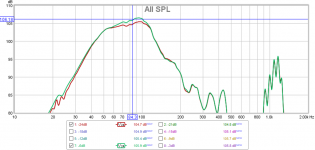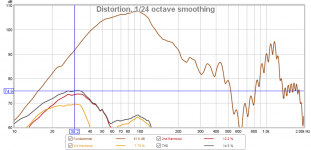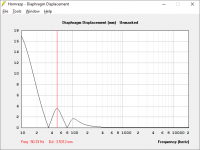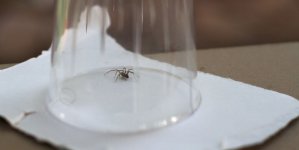Many (as in just over 20!) years ago, before I became more familiar with subwoofer design techniques, I built a small 4th order BP "subwoofer" using two Pyramid W61 6.5" drivers. The build, which I called "El Uglito" (because the box was terrifically ugly until I encased it in fiberglass) is documented at this page: ElUglito
This subwoofer currently serves as part of a 2.1 system that my youngest daughter currently uses in her bedroom. The W61 drivers were replaced long ago with Madisound 6204R-4 drivers, and the subwoofer is connected directly to the amp, with no filtering. The main speakers are the "Mini-Mes" (not documented anywhere), which I built sometime ago as garage speakers, and they roll off naturally above 100 Hz, which means that the subwoofer is a good match for them.
My daughter wanted to use that 2.1 system to provide music for a small get-together that they're having tonight at a villa that they rented for the purpose. After a brief talk about efficiency, and SPL requirements for such gatherings, I managed to convince her to use my "Blastoramas" instead. However, I thought I'd take a closer look at the "Uglito" build to see how it stands up to what's available today.
After building a sim for the subwoofer in Hornresp, it looks obvious that the drivers are the weak point. The sim suggests that their published Xmax of 3.5mm will be exceeded with just 3.1V into the combined 1.7 ohm impedance, which works out to just 5.7W into the subwoofer. And a quick linearity test suggests that distortion starts to become audible from a lower voltage - just above 2.6V. The amp is rated at 30W into 4 ohms, suggesting a drive voltage of around 11V, quite a bit higher. The 6204R drivers have managed to survive occasional abuse of the amp's volume knob, but probably didn't sound very good when doing so!
Interestingly enough the FR predicted by Hornresp is not the best match for the subwoofer's measured FR across its passband - the simple spreadsheet that I put together using the lumped mass model proved to be more accurate. However Hornresp did however correctly predict the out of band peak in the FR at around 1.2kHz.
Much more interesting IMO was the results of the linearity testing (which I do for every subwoofer build now, basically measuring its FR and distortion in 3dB steps, up to the design input voltage). Have a look at the attached graph, which shows the -24dB curve and the -6dB curve, adjusted upwards by 24dB and 6dB respectfully. The results suggest that the efficiency of the subwoofer INCREASES in the passband as the drive voltage goes up, at least until the drivers enter non-linear territory. The FR near the drivers' linear output capability is also a closer match for the predicted FR, than it is at lower input levels - the "-6dB" curve is a better match for the prediction than the "-24dB" curve.
This one is perplexing - any ideas on what might be causing this?
I suspect "cone-sag" (after all, the drivers are more than a decade old), which I will confirm soon enough when I replace the drivers with some new ones. I'm currently considering the Visaton WS-17Es, which will provide similar efficiency, and increase linear SPL capability by almost 6dB at lower frequencies.
This subwoofer currently serves as part of a 2.1 system that my youngest daughter currently uses in her bedroom. The W61 drivers were replaced long ago with Madisound 6204R-4 drivers, and the subwoofer is connected directly to the amp, with no filtering. The main speakers are the "Mini-Mes" (not documented anywhere), which I built sometime ago as garage speakers, and they roll off naturally above 100 Hz, which means that the subwoofer is a good match for them.
My daughter wanted to use that 2.1 system to provide music for a small get-together that they're having tonight at a villa that they rented for the purpose. After a brief talk about efficiency, and SPL requirements for such gatherings, I managed to convince her to use my "Blastoramas" instead. However, I thought I'd take a closer look at the "Uglito" build to see how it stands up to what's available today.
After building a sim for the subwoofer in Hornresp, it looks obvious that the drivers are the weak point. The sim suggests that their published Xmax of 3.5mm will be exceeded with just 3.1V into the combined 1.7 ohm impedance, which works out to just 5.7W into the subwoofer. And a quick linearity test suggests that distortion starts to become audible from a lower voltage - just above 2.6V. The amp is rated at 30W into 4 ohms, suggesting a drive voltage of around 11V, quite a bit higher. The 6204R drivers have managed to survive occasional abuse of the amp's volume knob, but probably didn't sound very good when doing so!
Interestingly enough the FR predicted by Hornresp is not the best match for the subwoofer's measured FR across its passband - the simple spreadsheet that I put together using the lumped mass model proved to be more accurate. However Hornresp did however correctly predict the out of band peak in the FR at around 1.2kHz.
Much more interesting IMO was the results of the linearity testing (which I do for every subwoofer build now, basically measuring its FR and distortion in 3dB steps, up to the design input voltage). Have a look at the attached graph, which shows the -24dB curve and the -6dB curve, adjusted upwards by 24dB and 6dB respectfully. The results suggest that the efficiency of the subwoofer INCREASES in the passband as the drive voltage goes up, at least until the drivers enter non-linear territory. The FR near the drivers' linear output capability is also a closer match for the predicted FR, than it is at lower input levels - the "-6dB" curve is a better match for the prediction than the "-24dB" curve.
This one is perplexing - any ideas on what might be causing this?
I suspect "cone-sag" (after all, the drivers are more than a decade old), which I will confirm soon enough when I replace the drivers with some new ones. I'm currently considering the Visaton WS-17Es, which will provide similar efficiency, and increase linear SPL capability by almost 6dB at lower frequencies.
Attachments
Brian,The results suggest that the efficiency of the subwoofer INCREASES in the passband as the drive voltage goes up, at least until the drivers enter non-linear territory. The FR near the drivers' linear output capability is also a closer match for the predicted FR, than it is at lower input levels - the "-6dB" curve is a better match for the prediction than the "-24dB" curve.
This one is perplexing - any ideas on what might be causing this?
Perhaps the additional distortion at higher levels adds to the upper SPL?
Perhaps the additional distortion at higher levels adds to the upper SPL?
I thought of that, but no, I don't think that the THD at lower levels is not high enough to do this, plus that distortion is probably gated away anyway as part of the FR measurement. Have a look at the attached graph that shows the THD at -6dB. It peaks at 14.5% at 30 Hz, and output at that frequency is 12-18dB way below the passband level. There's no way that's going to lift the response at 90 Hz by 2~3dB....
Another interesting thing - between -12dB and -3dB, THD from about 55 Hz up actually DECREASES at the input level is increased. Not by much, but it is noticeable on the graphs. The reduced distortion over this section of the passband shows one of the major advantages of 4th order BP systems - it's likely being filtered by the vent
Attachments
It just occurred to me that I could perhaps significantly reduce distortion at lower frequencies AND increase the power-handling, passband response and SPL capability of "Uglito" by converting it to a series-tuned 6th order BP build, with the lower Fb at around 34 Hz. The sims look good and show that peak excursion will occur somewhere around 50 Hz. The great thing about this is that the main vent will filter out all HD above the 2nd HD (100 Hz), so even if the driver is driven past Xmax, the result won't be that audible. Distortion all the way down to the lower Fb should be reduced, perhaps significantly, as between 21 Hz and 45 Hz, most of the THD is 2nd order and therefore likely driver-related.
How am I going to do it? Well, the sim suggests that all I need to do is to drill at 1" hole between the sealed and vented sections of the subwoofer, that's all. Yeah, it's a small vent, but the resonant frequency is quite a bit below the passband, and any annoying distortion generated by small vent is going to be filtered out by the main one anyway .
.
How am I going to do it? Well, the sim suggests that all I need to do is to drill at 1" hole between the sealed and vented sections of the subwoofer, that's all. Yeah, it's a small vent, but the resonant frequency is quite a bit below the passband, and any annoying distortion generated by small vent is going to be filtered out by the main one anyway
Attachments
The results suggest that the efficiency of the subwoofer INCREASES in the passband as the drive voltage goes up...
This one is perplexing - any ideas on what might be causing this?
I suspect "cone-sag"
Could be cone sag (suspension creep), could be the Bl and Cms just play together nice at a particular operating point - the operating point could be moving in and out of the gap in a level-dependent manner. Perhaps a cupped spider?
Attachments
I have to be honest: the 'ugliness' of the El Uglito deserves a place. It's kind of cute.
What you are seeing are pictures of it AFTER I "squared" it off with several coats of fiberglass and resin. You should have seen in before - a basic 3/4" ply box with almost no angles that were properly square. My carpentry skills are awful now - they were even more awful back when I built that.
Could be cone sag (suspension creep), could be the Bl and Cms just play together nice at a particular operating point - the operating point could be moving in and out of the gap in a level-dependent manner. Perhaps a cupped spider?
I believe that these drivers do have cupped spiders. In fact, if I remember correctly, the spiders on both had a particular "flaw", in that part of them would flex strangely at a certain excursion. You might be on to something there...
- Status
- This old topic is closed. If you want to reopen this topic, contact a moderator using the "Report Post" button.
- Home
- Loudspeakers
- Subwoofers
- Revisiting the Uglito...



